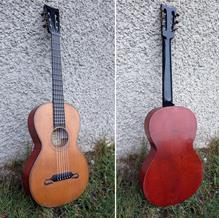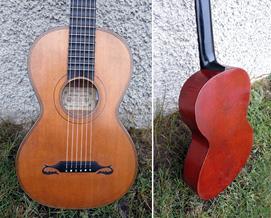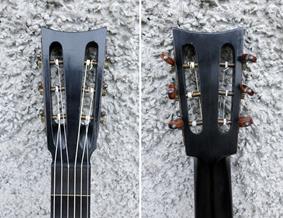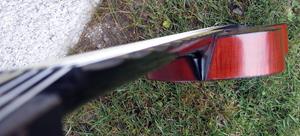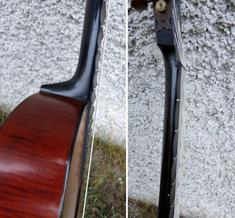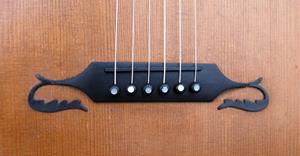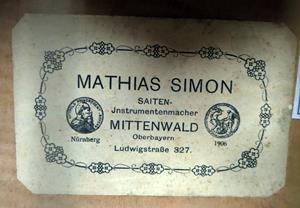The other one that has been completed in a few days is a dated and labeled (!) Nylon string string. Beautiful and light build in the style of romantic guitars. It was old-fashioned when it was built in 1918. Built by Matthias Simon, Mittenwald. He apparently received a bronze medal in 1905 for his finely built harp guitars. It is noticeable that the builder knew his stuff! The tuning screws are not violin screws in wood, otherwise it is similar to the small and light guitars that were built in the first half of the 1800th century.
Good condition except for curved neck and a cracked stable. The lid had also collapsed a little in front of the stable and around the sound hole.
The most special is the scalloped board. Another nice detail is the decorations in ebony on both sides of the stable. The original stable was cracked and very thin, 3 mm, in ebony. No stable leg, the strings rested on the front edge directly on an elevation of the stable where the builder let the wood be 7 mm. The year was like a pencil note in the lid, it happens sometimes but too rarely that you know the exact year.
Tried to loosen the fretboard, but it turned out to be hopeless. In the thinnest part between the straps, the "fretboard" was less than 0,5 mm thick. More like a veneer. In addition, the ebony was brittle and the glue sat like just that. Had to scrape and chisel it away. The slender neck of the maple had received minimal help from the thin board and had a banana bend. Did not loosen the neck but only opened the bottom. Could not see exactly how the neck was attached, but it sat well and the direction was right. It was allowed to remain. Mill a carbon fiber rod into the neck after a warm-up so that it became straight.
Inside, the ribs were very spartan, three thin ribs in the lid and bottom. Since it was to be stretched with nylon strings, I made the new ribs almost as small, but I changed the pattern a bit to make the lid stronger. An A frame at the sound hole as well. The big job was to scallop a new board in ebony. The first time I did such a thing, but it went well with various rasps and sandpaper. Did a test with a machine also to make it faster, but could not control the machine so it had to be manual work. Took a whole day. Mounted old mandolin bands in brass on the peaks between the scallops.
The upper saddle and stable legs were made in black buffalo horn so as not to protrude. The original tuning screws were in good condition and reused. The whole guitar got a few layers of spirits after scraping the grip board and the bottom and biting with stains of the right color. The lid was either unpainted or it had disappeared almost completely. Very impractical with an unpainted lid and in addition, the tone drops tightly.
Made a new and more powerful stable in ebony, the decorations were glued back on both sides. As I glued the bottom, I was careful to clamp a steel beam on the grip board and align the beam right to the top of the stall. The bottom was glued where it should then end up and a small overhang at the back was scraped away. A way to change your neck without doing it. A small radius on all the lids also helped to straighten the neck.
Weighs 939 grams, light as a spring. 61 cm mensur. Slim neck and grip board, 45 mm at the upper saddle. Very fun to play on actually with nylgut strings on the unspun. Not often do I like nylon string guitars! Smooth tone, sounds good without wolf tone. Little finished pictures
Old Gura becomes international in that it is sent to the buyer in France. Has shipped some GG to Norway (and one to Doug Seegers in the US), but this one is the first to the continent 🙂
What was it like playing on a scalloped board? Less special than I actually thought. Felt like usual. One advantage is that you do not come in contact with the board. No scratch on the board and no dirt on your fingertips. If you are easy on the hand you have no problems with the intonation, but if you press hard it can become unpleasant especially with chords. Consciously pushing to pitch is difficult, it doesn't happen that much unless you take it in properly. No revolution, just something you quickly get used to just like a different neck.

